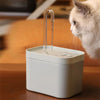How Tight Should a Dog Collar Be? A Comprehensive Guide for 2025

How Tight Should a Dog Collar Be? A Comprehensive Guide for 2025
Choosing the right collar and ensuring it fits properly is crucial for your dog's comfort and safety. A collar that's too tight can cause injury, while one that's too loose can easily slip off, leading to escapes and potential hazards. This guide will help you determine the perfect fit for your canine companion.
Why Proper Collar Fit Matters
A well-fitting collar is essential for several reasons:
- Comfort and Safety: A collar that's too tight restricts breathing and blood circulation, leading to discomfort and potentially serious health issues. Conversely, a loose collar presents a choking hazard or can easily come off during walks or playtime.
- Effectiveness: Whether for identification tags, leashes, or training devices, a properly fitted collar ensures optimal functionality. A loose collar will slip, rendering it useless. A too-tight collar can cause discomfort and make your dog resistant to wearing it.
- Prevent Injury: A poorly fitting collar can rub and chafe the dog's neck causing sores and hair loss. In extreme cases, it could even lead to serious skin infections.
The Two-Finger Rule: The Gold Standard
The most reliable method to check your dog's collar fit is the two-finger rule. Place two fingers between the collar and your dog's neck. If you can comfortably fit two fingers, the collar is properly adjusted. If you can't fit two fingers or can fit more than two, adjust accordingly.
Different Collar Types & Fitting
The ideal fit can vary slightly depending on the type of collar:
- Flat Collars: These are the most common type and should adhere to the two-finger rule. Make sure the buckle is not digging into your dog's neck.
- Martingale Collars: Designed for dogs who slip out of regular collars, these tighten slightly when tension is applied but should still allow for two fingers to fit when relaxed.
- Harness: While not technically a collar, harnesses should also provide a comfortable and secure fit. It should be snug but not constricting, allowing your dog freedom of movement. Look for proper adjustment straps to ensure an optimal fit.
- Choke Chains and Pinch Collars: These should only be used under the guidance of a professional dog trainer and never left on unsupervised. Even with professional supervision, it is important to ensure they do not become too tight.
Regular Collar Checks are Essential
Your dog's neck size can change over time due to growth, weight fluctuations, or muscle development. It’s vital to regularly check your dog's collar for a proper fit, ideally every few weeks or monthly. Pay attention to any signs of irritation or discomfort, like redness, scratching, or hair loss around the neck. Don't hesitate to adjust the collar or replace it if needed.
Signs of a Collar That's Too Tight
- Redness or irritation around the neck
- Hair loss
- Difficulty breathing
- Excessive scratching or pawing at the neck
- Your dog pulling away or resisting when you put on the collar
Signs of a Collar That's Too Loose
- Collar slips off easily
- The collar slides up and down the dog's neck
- The collar might choke your dog if the leash gets caught
Conclusion
Finding the right collar fit for your dog is essential for their safety, comfort, and well-being. Remember to use the two-finger rule, regularly check for proper fit, and always prioritize your dog's comfort. If you have any concerns, consult with your veterinarian or a professional dog trainer.




